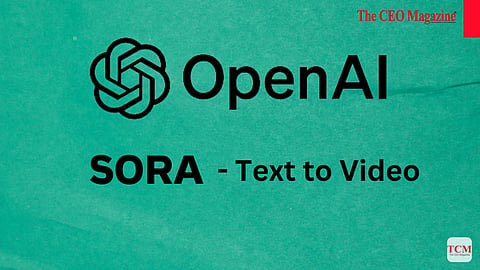
- News
- Women
- Magazine
- IndustryIndustry
- InsightsInsights
- Success Stories
- PublishPublish
- ContactContact
- Media KitMedia Kit

OpenAI SORA
OpenAI did it again. First, they introduced ChatGPT, which can engage in natural and informative conversations, answer questions, generate text, and provide assistance on a wide range of topics. And now, they have introduced SORA a text-to-video AI model that can create realistic and imaginative scenes from text instructions.
Sora can transform mere words into vivid, lifelike scenes. Through sophisticated algorithms, Sora can interpret textual instructions and translate them into captivating videos.
This innovative text-to-video model holds immense promise, promising to revolutionise various aspects of our lives. Join us on the exploration of Sora and its potential to redefine our interaction with the digital world.
As Sora becomes available to red teamers to assess critical areas for risks or harm, a big change is happening. Also, a lot of visual artists, designers, and filmmakers can now use it and give feedback on how to make it better for creative people.
This early sharing of research is to work with people outside of OpenAI and to show everyone what AI can do soon. Sora is good at making detailed scenes with many characters and different movements and getting everything right about what's there.
Sora really understands words, so it knows what people want and how things are in real life. It can make characters in videos show strong feelings, and it can make lots of different shots in one video that look just right.
The current iteration of the model exhibits certain weaknesses that merit consideration. It may encounter difficulties in accurately simulating the intricate physics of a complex scene, leading to potential discrepancies.
Additionally, there may be instances where the model fails to grasp specific cause-and-effect relationships, resulting in inaccuracies. For instance, it might struggle to depict a scenario where a person takes a bite out of a cookie, yet the cookie remains intact without a visible bite mark.
Spatial orientation poses another challenge, with the model sometimes confusing left and right directions. Moreover, it may struggle to provide precise descriptions of events unfolding over time, such as tracking a particular camera trajectory throughout a sequence. These weaknesses show there is a need for improvement in enhancing the model's performance and accuracy.
Ahead of making Sora available in OpenAI's products, several crucial safety measures are being taken. Collaboration with red teamers and experts in areas such as misinformation, hateful content, and bias is underway to adversarially test the model.
Tools are also being developed to detect misleading content, including a detection classifier capable of identifying videos generated by Sora. Plans are in place to incorporate C2PA metadata if the model is deployed in an OpenAI product.
Additionally, existing safety protocols developed for products like DALL·E 3 are being leveraged for Sora. For instance, a text classifier will screen and reject input prompts that violate usage policies, such as those requesting extreme violence, sexual content, or hateful imagery.
Robust image classifiers are also being employed to review every video frame generated, ensuring adherence to usage policies before being presented to users.
OpenAI intends to engage policymakers, educators, and artists globally to address concerns and explore positive applications of this technology. Despite extensive research and testing, anticipating all potential uses and abuses of the technology is challenging. Hence, learning from real-world usage is deemed crucial for continually improving the safety of AI systems.
Sora utilises a diffusion model to create videos, starting with static noise and gradually refining it over multiple steps. This approach allows for the generation of entire videos at once or extending existing ones seamlessly.
To maintain consistency in the subject's appearance, even during temporary occlusion, the model employs foresight by considering multiple frames simultaneously—a solution to a challenging problem in video generation.
Similar to GPT models, Sora utilises a transformer architecture, enabling enhanced scalability. Videos and images are represented as collections of smaller data units called patches, akin to tokens in GPT. This unified data representation allows diffusion transformers to handle a broader range of visual data, including varying durations, resolutions, and aspect ratios.
Drawing from past research in DALL·E and GPT models, Sora incorporates the recaptioning technique from DALL·E 3, generating descriptive captions for visual training data to enhance fidelity to user instructions.
Beyond text-based instructions, Sora can also animate still images accurately and fill in missing frames in existing videos. These capabilities are elaborated in our technical report.
Sora serves as a foundational step towards models capable of understanding and simulating the real world—a significant advancement towards achieving Artificial General Intelligence (AGI).
Follow us on Google News
